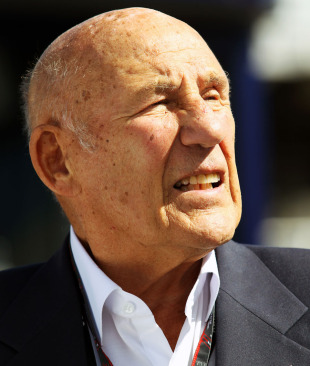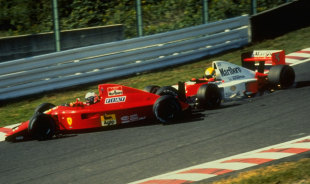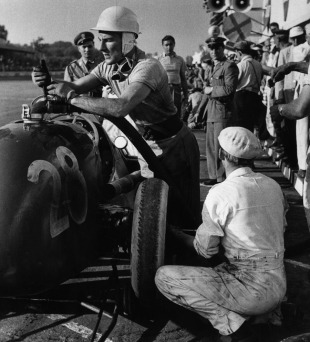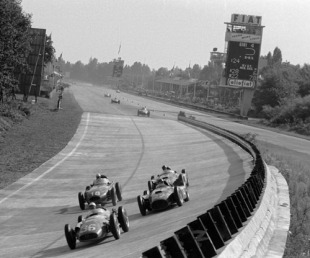
- News:
-
Barrichello accepts Schumacher's SMS apology
- News:
-
Schumacher apologises to Barrichello
- News:
-
Rubens fumes at 'dangerous' Schumacher move
- Drivers:
- Rubens Barrichello
- |
- Juan Manuel Fangio
- |
- Nino Farina
- |
- Stirling Moss
- |
- Michael Schumacher
- Circuits:
- Autodromo Nazionale Monza
I'm quite aware that Formula One has changed since my day but one thing that is never excusable is dirty driving. I was appalled to watch Michael Schumacher nearly drive Rubens Barrichello into the wall at the Hungarian Grand Prix and the photos show that he got within inches of causing a major accident.
He was punished with a 10-place grid penalty in Belgium, but for me that only proves that the FIA has got no teeth. In my view he should have been banned for a year, maybe more. If somebody had been coming out of the pits it could have been an enormous shunt and that kind of risk is inexcusable.
The irony is that the improvement in safety in our sport has created a devil-may-care attitude among some of the drivers. Schumacher was willing to push Barrichello into a wall at 180mph, but I can't believe that if you gave him a loaded gun he would consider shooting him. There is an underlying assumption that things will be OK, and for the most part they will be nowadays, but we are still talking about a concrete wall and a car travelling at very fast speeds.
I experienced dirty driving when I was racing, for example Nino Farina was very aggressive. He put me in a very compromising position in 1951 at Bari but I just backed off and it backfired on him; he ended up oversteering wide and lost more time than I did. Juan Manuel Fangio passed us both and I remember as he went by he was grinning because Farina's move had been silly and it hadn't paid off. That's the thing with these desperate moves, they seldom work.

There is an argument that says if you discipline drivers then you discourage overtaking, but I don't see that as a good reason not to punish them appropriately. In my mind you're either a dirty driver or you're not, and the difference is quite obvious to anyone who understands the sport. What's more, I don't remember any dirty drivers who tidied up their act later in their career.
The other problem is that the money in the sport creates a win-at-all-costs mentality. There is no room for sportsmanship when drivers are getting paid millions and when the difference between winning and losing is so great. When I was driving the money was incidental by comparison, obviously you would look at the prize money when entering certain races and that might affect which races you took part in, but it didn't affect the way you drove at those races. I'm sure some of the drivers want to put on a good show nowadays but the sporting side of it went out of the window a long time ago.

The next race is the Italian Grand Prix at Monza and that is a perfect of example of a circuit that has become safer over the years. When I think of how dangerous that place used to be and how it is now, I'm not surprised the drivers take a few liberties. If a driver goes off knowing that he has got 20 metres of tarmac or a gravel trap to play with he is going to take risks. If there was a bloody great precipice there, the buggers wouldn't play around I can tell you.
Monza used to be such a demanding place, the old Curva Grande was a very, very difficult corner but of course that has been emasculated by putting a chicane ahead of it, spoiling it completely. In the modern era they also have the advantage of downforce, which is like having a hand pressing down on the car from above. The really fast corners often become part of the straights.
Back in the mid 1950s and early 1960s we also had the banking to contend with, and you had to set the car up for that by sacrificing the handling on the road part of the course. For the banking you needed much stiffer springs but that meant the car would slide a lot, making corners like the Curva Grande and Curva di Vialone (another emasculated corner and now the Ascari chicane) very difficult.
I remember driving a Maserati Eldorado Special (a converted 250F) there in 1958 at the Two Worlds Trophy and all of a sudden my arms crossed as I was going round the banking. I'm not stupid, I knew immediately that something had gone wrong and it later turned out that the steering had sheered. All I could do was put my foot on the brake, close my eyes and wait for the impact.

Looking back, it was an awful accident because I knew there was nothing I could do to prevent the shunt. Normally you go into damage prevention mode and fight the car, but with no steering all I could do was slam on the brakes. That wasn't particularly reassuring because I was sure I was going to go over the top of the banking and if I had I would have been finished.
That kind of danger gave drivers something to think about before they did anything silly on the track.
© ESPN Sports Media Ltd.
 Sir Stirling Moss OBE - a British motor racing legend, recognised as one of the world's greatest racing drivers. He won an astonishing 212 of the 529 races he entered during his 15-year career, competing in just about every class of motor racing, including 16 Formula One races. His victory in the 1961 Monaco Grand Prix is one of the most famous races in F1 history. Stirling's vast experience comes from being a racer and from knowing those who compete in and run the sport now. He never shies away from commenting on all aspects of the sport he loves. Gallery of his career
Sir Stirling Moss OBE - a British motor racing legend, recognised as one of the world's greatest racing drivers. He won an astonishing 212 of the 529 races he entered during his 15-year career, competing in just about every class of motor racing, including 16 Formula One races. His victory in the 1961 Monaco Grand Prix is one of the most famous races in F1 history. Stirling's vast experience comes from being a racer and from knowing those who compete in and run the sport now. He never shies away from commenting on all aspects of the sport he loves. Gallery of his career

